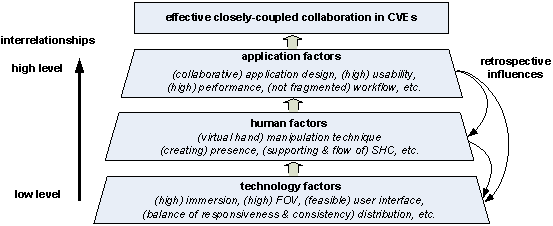Chapter 8: Factors influencing distributed collaboration in immersive CVEs
Natural object-focussed collaboration in distributed virtual environments is the main focus of this work and this chapter will discuss what is known and has been learned to improve such collaboration. So far this thesis has reasoned that immersive CVEs are suitable for distributed collaboration and various studies using the Virtual Gazebo benchmark application have proven that such collaboration is possible and can be effective. Chapter 1 introduced the notion that the research problem for natural object focussed collaboration is more than just connecting immersive displays using CVEs as it depends on the right settings.

The choice of display and technology affects immersion, field of view (FOV), interface and these subsequently workflow, social human communication (SHC) and performance. In addition, the choice or respectively design of application needs to reflect display properties, and influences through distribution and task design. For example, the user interface does not necessarily depend on workflow, but the workflow depends on a usable user interface, application design, support for SHC, etc. Therefore we can categorise those factors into different relationship levels supporting closely-coupled collaboration (Figure 8-1). At the lowest level we find technological factors such as immersion, FOV, user interface, distribution, etc, which influence human factors (e.g presence, SHC, manipulation technique, etc). Both levels have further impact on application factors such as task design, usability, performance, workflow, etc. However, the higher levels have impact onto the lower levels as well.
This research has looked closely into some of these issues whereas others are well known and discussed in the early part of this thesis. Like in a big puzzle these factors have to be combined to understand the bigger picture of its multi-dimensional relationships. Therefore, the following sections will discuss the above interrelationships in more detail and will combine various parts of the thesis to build on overall picture (Figure 8-1).
The choice of display and technology affects already immersion, FOV, interface and subsequently workflow, SHC and performance. In addition, the choice or respectively design of application needs to reflect display properties, and influences through distribution and task design. For example, the user interface does not depend on workflow, but the workflow depends on user interface, task design, support for SHC, etc. Therefore we can categorise those factors into different relationship levels supporting closely-coupled collaboration (Figure 8-1):
- low level: technology factors (immersion, FOV, user interface, distribution, etc);
- mid level: human factors (presence, SHC, manipulation technique, etc);
- high level: application factors (task design, usability, performance, workflow, etc)
It is not enough to design a system which focuses only on few of these factors, as they have influence on others with further impact on the application’s usability. A system incorporating those parameters will not only have a good support for closely-coupled collaboration but also any other (“loose”) forms of collaboration. Immersive CVEs appear promising for the support of distributed group collaboration and seem to be good for studying people’s behaviour during such collaboration.
 Deutsch
Deutsch  English (UK)
English (UK)